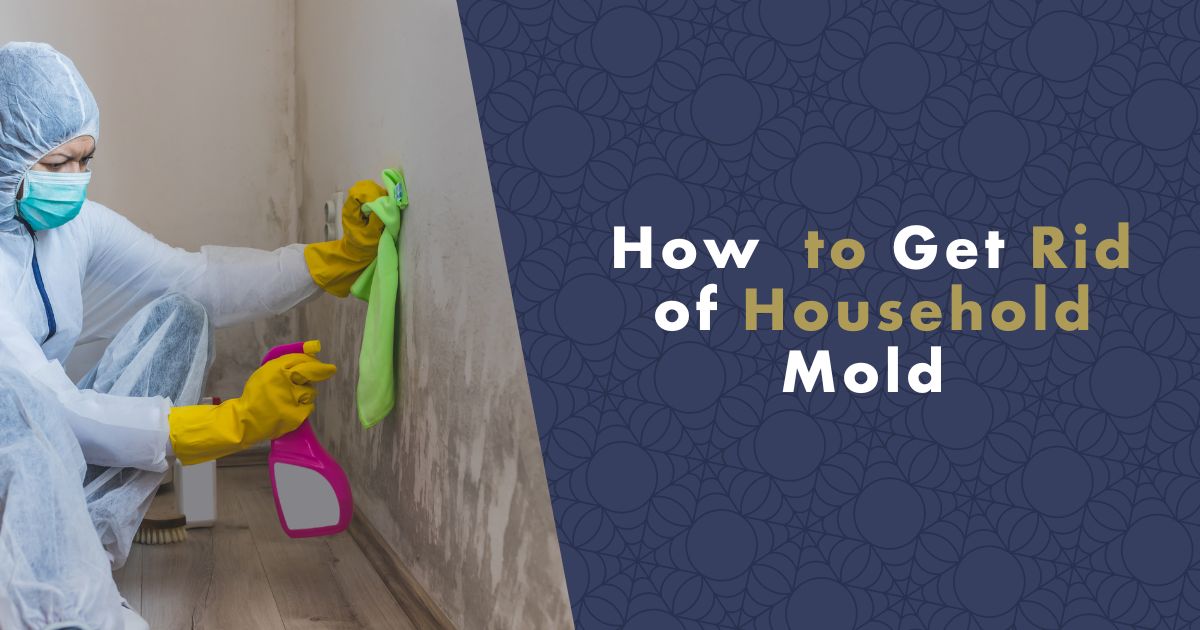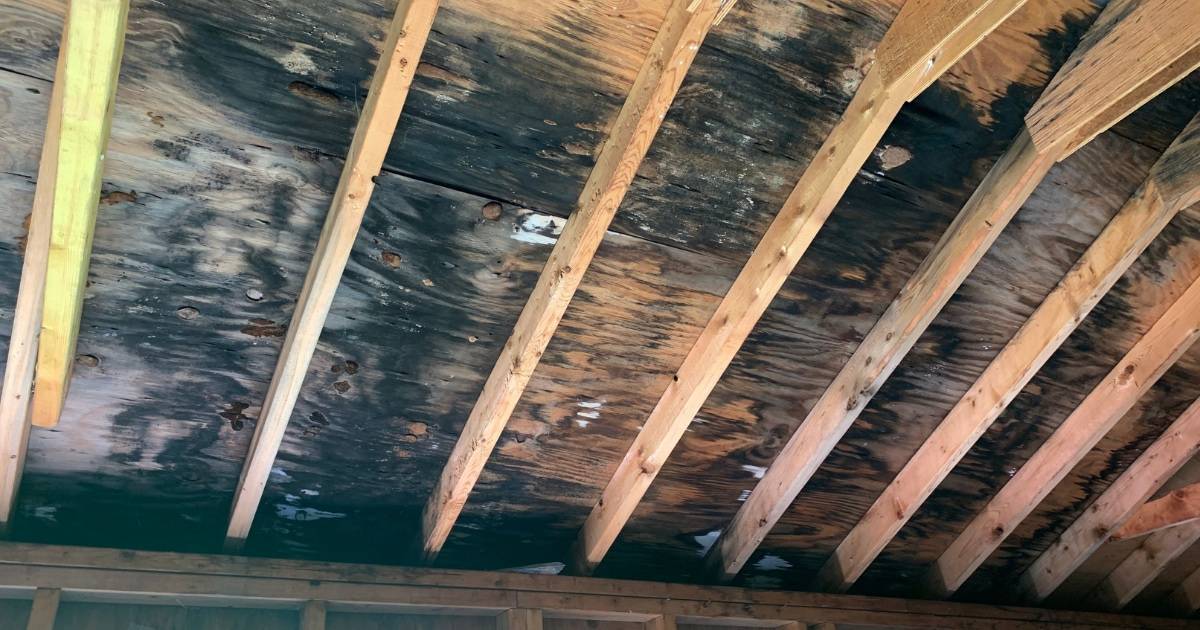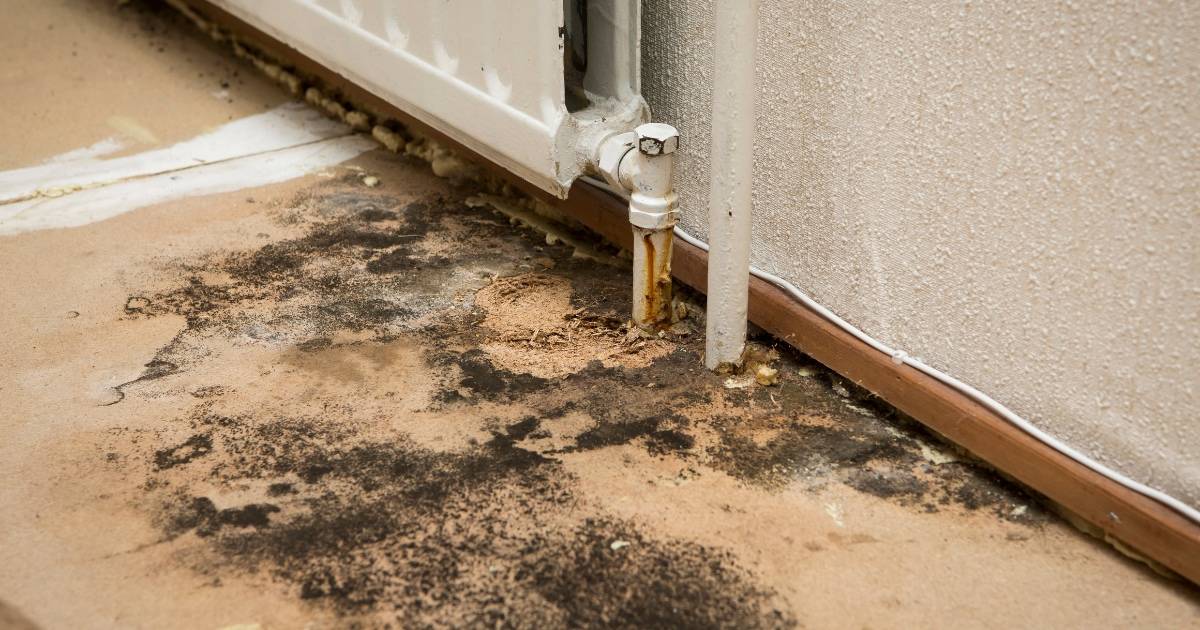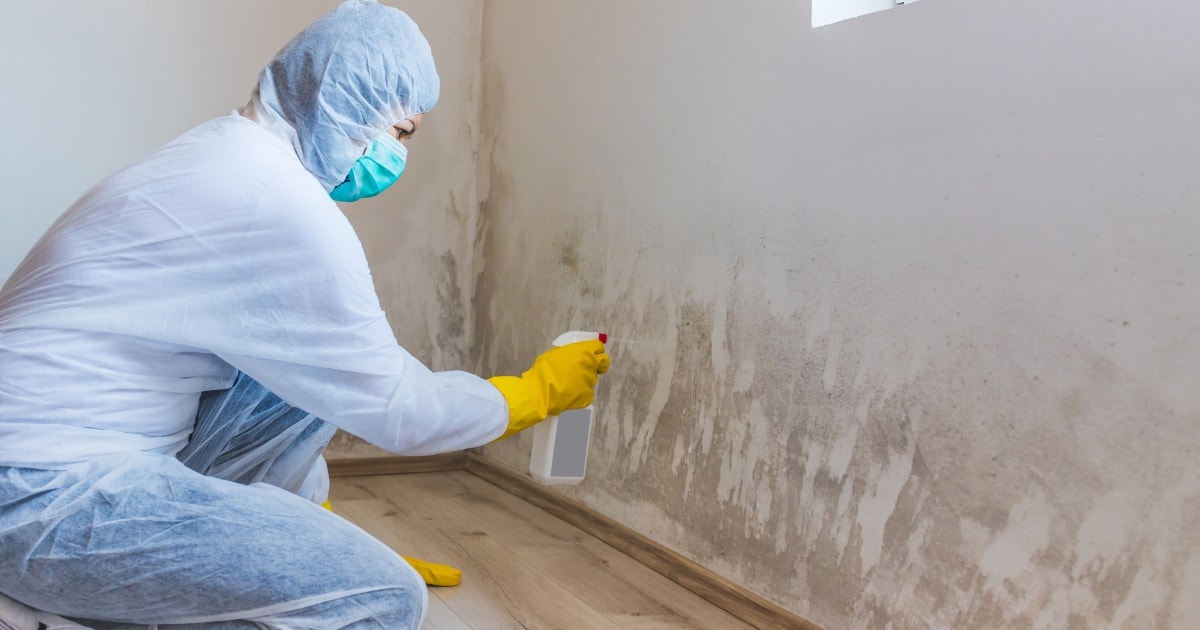Many people struggle with mold problems in their households. Mold can cause health issues such as allergies and asthma, and it can also damage our belongings. Therefore, it is important to remove mold from the household as quickly as possible. This article offers several simple tips and advice on how to effectively get rid of mold in the household. We will look at dehumidifiers and ozone generators, which are so popular for mold removal and prevention in basements and households.

How Does Mold Develop in an Apartment?
Mold is very common in buildings and households. Mold will grow in places with high humidity, such as around leaks in roofs, windows, and pipes, or where flooding has occurred. Mold thrives on paper products, cardboard, ceiling panels, and wooden items. Mold can also grow in dust, paints, wallpapers, insulation, drywall, carpets, fabric, and upholstery.
Article tip: Allergies to Dust: Symptoms and Solutions
Mold Occurs Both Indoors and Outdoors
Mold can enter your home through ventilation openings and heating and air conditioning systems. Mold in outdoor air can also attach to clothing and shoes, as well as to your four-legged companion, who can then bring it home.
When mold spores fall in areas with excess moisture, such as where leaks have occurred in roofs, pipes, walls, flower pots, or where flooding has occurred, they grow.
Many building materials provide suitable nutrients that support mold growth. Wet cellulose materials, including paper and paper products, cardboard, ceiling tiles, wood, and wooden products, are particularly suitable for the growth of certain molds.
Other materials, such as dust, paints, wallpapers, insulation materials, drywall boards, carpets, fabrics, and upholstery, commonly support mold growth.

How to Recognize Mold?
- The room smells like mold or has an earthy, musty odor.
- You notice signs of water damage, such as stains or bulging drywall panels.
- You experience physical symptoms of sensitivity to mold (especially when you are in your apartment), such as a stuffy nose, watery eyes, cough, or breathing problems.
- Your apartment has visible signs of mold growth on surfaces.
Causes of Mold Formation
Mold needs six elements to grow. Omitting any of them will prevent mold cultures from establishing or flourishing. If one or more of these elements are removed, the mold colony will die. Reducing or eliminating these elements is a fundamental mold prevention strategy.
Here are six factors that cause and contribute to mold growth and spread.
Where Does Mold Come From?
The first element is mold spores themselves. It is difficult to prevent this because mold microorganisms are abundant and almost universally present worldwide. Spores are invisible to the naked eye and typically enter your home from the outside.
The movement of spores through the air is the most common way of spreading, followed by introduction through contaminated materials. Removing mold spores from your home is virtually impossible.
Where there's high humidity, there's mold
Mold cannot thrive without humidity, so everyone should have a hygrometer at home to monitor air humidity. A hygrometer costs a few euros and can help you address issues in time. The longer favorable humid conditions persist, the greater the chance that mold will start growing. Most household molds begin in hidden places. Minor leaks in plumbing under the bathroom or kitchen sink, which go unnoticed or unattended, are a common source of humidity. Mold can also start in places you don't even see, like ceilings.
Molds can also affect walls due to leaks from cracked plumbing, waste, and ventilation pipes. Moisture can also result from condensation where plumbing pipes are cooled, and high-humidity environments cause them to sweat.
Bathrooms are known for harboring active mold growth. Corners of showers that never fully dry are common places where you'll see small black spots forming on grout.
Shower curtains and door tracks are other places where mold starts. Moisture is a primary element necessary for mold existence. If you eliminate moisture sources with a dehumidifier, you can win the battle against mold.
Mold needs food to reproduce
Since mold is a form of life, it needs food for survival and reproduction. When you find mold in your bathroom or a corner of your closet, it feeds on organic materials contained in wooden panels or wallboards. It also feeds on tiny amounts of dust and dirt that are present regardless of how well you clean.
Mold can thrive on various things around your home. It can feed on insulation in your attic or walls and consume the backside of drywall. Mold devours fabric and luggage surfaces. It consumes residues left on smooth tile surfaces and microscopic particles trapped within porous floors like carpets. And it loves damp cardboard, newspapers, and fabrics.
Mold also derives sustenance from the air. Spores aren't the only microscopic elements present in the air circulating throughout your home that you breathe in. There are countless particles in the air that mold can feed on, such as dust and pollen. The air even contains spores of other mold species, contributing to their diet.
Mold requires air for growth and reproduction
Without oxygen, mold cannot perform the organic process that involves cell division and mass formation.
Air contributes not only to the physical, chemical, and biological growth of mold, but air movement is a major transporter of mold spores. Just as with food sources, it's practically impossible to remove air from places where mold forms. In fact, we can combat mold with a large volume of air, meaning frequent and thorough ventilation, for instance.
Darkness supports mold growth, direct sunlight is deadly
Direct sunlight is deadly for mold. Ultraviolet rays in natural sunlight destroy the cellular structure of mold. This is why you only find mold outdoors in dark places.
Indoor lighting doesn't have the same devastating effect on mold as sunlight. The spectrum of artificial light differs from sunlight and doesn't emit the same photons that kill mold and stop its spread.
Although mold prefers low light or even complete darkness, it still grows indoors where incandescent or fluorescent lights shine. It's not practical or economical to have sunlight in every corner of the house, but there are types of indoor lighting on the market that mimic solar wavelengths and can eliminate mold with exposure. Unfortunately, this isn't practical either. Mold thrives where light is limited, but warmth and humidity are sufficient. So, working with humidity is more important, but optimal room temperature can also help.
Mold doesn't tolerate excessively cold or hot environments.
You won't find mold in Arctic regions, nor will you find it in the Sahara Desert. Freezing destroys mold, or at least puts it to sleep. Burning also breaks down mold's cellular structure, preventing its growth and reproduction.
Indoor temperatures are at optimal levels for mold culture. Temperatures between 22 to 27 °C (71.6 to 80.6 °F) are ideal for mold growth, especially in humid and dark climates. Mold spores can't settle close to freezing, but they can survive temperatures uncomfortable for humans. Relative humidity is also a crucial factor for mold development. High humidity provides a moist environment that promotes mold growth. In winter, you should maintain indoor humidity between 45 and 60%, and in summer, between 40 and 55%. If you're unsure about your indoor humidity levels, it's recommended to get a hygrometer before addressing indoor humidity with a dehumidifier. You might need a dehumidifier in winter and a humidifier in summer, or vice versa.

Health Risks of Mold
Exposure to a significant amount of mold spores can lead to allergic symptoms such as watery eyes, runny nose, sneezing, itching, coughing, wheezing, breathing difficulties, headaches, and fatigue. Repeated exposure to molds can increase sensitivity and cause more severe allergic reactions.
These issues are worse indoors, where molds contribute to air quality problems. Some molds, like Stachybotrys and Aspergillus, can produce toxins called mycotoxins under specific conditions. Exposure to mycotoxins can lead to more serious illnesses.
Tip: How to Recognize Allergies
People living or working in buildings exposed to moisture and inadequate ventilation are more susceptible to mold-related illnesses.
Especially vulnerable populations include: infants and children, older adults, individuals with weakened immune systems, and those with existing respiratory issues, such as allergies and asthma.
Getting Rid of Mold
If you see or smell mold, it's present and needs to be cleaned. You also need to address the underlying issue causing mold growth to prevent its recurrence.
Before cleaning mold, it's crucial to eliminate sources of moisture. If you discover through a hygrometer that you have excessive humidity, you'll need to use an air dehumidifier.
If you don't, mold will grow again. If the mold growth area is larger than 30 x 30 cm, it's recommended that a professional with mold remediation experience handle the cleanup. If the area is smaller, you can usually tackle the job yourself in most cases.
1) Mechanical Removal
You'll recognize basement mold by its appearance – typically black, white, or bluish spots on walls. It can also grow on any organic material adjacent to moldy areas, such as carpets, cardboard boxes, etc.
Remove these affected items from the wall and dispose of what you can. Furniture can often be saved with a good cleaning, but in some cases, it might need to be discarded. Clearing these items from the area also gives you space to work during mold removal.
There are many commercial mold-killing products available. However, bleach is considered the best substance for mold elimination, especially when combined with mechanical scrubbing.
Mix one part bleach with three parts water in a bucket. Use a scrub brush or sponge to scrub the mold-affected wall with the bleach and water solution until the mold stains are gone.
In some cases, it may be necessary to let the solution sit on the wall for several minutes after application to allow it to penetrate.

2) Chemical Removal
Wear rubber gloves to protect your hands and safety goggles to prevent bleach solution from getting into your eyes. Also, wear a respirator or dust mask to avoid inhaling any mold particles that might become airborne. If possible, work in a well-ventilated area. Wear old clothing, as working with chemicals might damage them.
Tip: What is the best respirator against fine dust?
There are various chlorine products that can help you combat mold in your home. These products are easy to apply—usually spraying from about 10 cm onto the affected area and letting it sit for around 20-30 minutes. Allow the solution to dry or rinse with water, and you're done. However, be cautious not to disturb the mold before using a liquid, as it could release toxic spores into the air.
3) Ozone Generators
Ozone is one of the most powerful oxidative agents known; it doesn't only eliminate bacteria and viruses but can also eradicate odors and mold.
Ozone is also used in drinking water treatment, and you might be familiar with its distinctive smell around swimming pools. This process is called ozonation. Ozone generators work by utilizing active oxygen (O3/ozone), which reverts back to oxygen (O2) after application.
As an oxidizing agent, ozone has strong disinfectant effects and can be used in closed spaces in gaseous form.
Our TIP: Ozone Generators
#produkty#https://www.nanospace.store/ozone-generators/
Advantages of Ozone
- Over 50% more effective in breaking down bacterial membranes compared to chlorine.
- Destroys a wide range of bacteria more than 3000 times faster than chlorine.
- Strong disinfectant at low concentrations.
- Decomposes into gaseous oxygen, leaving no by-products that could pose health risks.
- Easily and economically produced on-site, ready for use.
Tip: Ozone Generator – Reliable Helper for Eliminating Viruses, Bacteria, and Odors
Mold Prevention
If you haven't heard about photocatalytic coatings and you're dealing with mold, it might be time to explore them. These coatings utilize the principle of photocatalysis and other physical properties of the contained materials to provide protective functions.
Unlike chemical solutions, the functionality of these coatings is virtually inexhaustible. The FN NANO® 3 functional coating is a water suspension of patented minerals with a high content of photoactive titanium dioxide (TiO2). The high TiO2 content and optimized mineral binder in the coating layer ensure exceptionally effective substrate protection. It's also suitable for extreme conditions in healthcare, industrial production, and toxic operations.
Tip: Discover the Magic of Photocatalytic Coatings: Cleaner Air and Pristine Walls
It's designed to create an upper mineral active photocatalytic layer that ensures air purification and microorganism reduction. The layer is white and suitable for all common types of plaster and masonry or drywall substrates.
Just like FN NANO® 3, FN NANO® 2 is suitable for indoor spaces. And you know what's best? It repels spiders! This feature will be particularly appreciated by women and children.
Our TIP: Self-Cleaning Coatings.
#produkty#https://www.nanospace.store/fn-nano-coatings/
Household Remedies for Mold Removal
Baking soda is well-known as a natural and safe household cleaning agent. It can also be used to combat mold in your home. Unlike other aggressive mold killers with chemicals, baking soda has a mild pH (8.1) and is harmless to your family and pets.
Vinegar is sometimes used together with baking soda for mold cleaning because vinegar kills different types of mold than baking soda.
To kill mold, add 1/4 tablespoon of baking soda to a spray bottle of water. Shake the bottle to dissolve the baking soda in water. Spray the moldy area with the baking soda and water solution. Use a sponge or brush to scrub the area. Rinse the surface with water to remove any leftover mold residue. Spray the area again and allow the surface to dry. This will kill all remaining mold and prevent its return.
You can also use a cloth instead of a spray bottle. Simply soak the cloth in water, add 1/4 tablespoon of baking soda, and scrub the moldy area. Rinse and repeat if necessary.
Additional Tips:
- Slaked Lime: Scrape off the mold with a putty knife and apply three layers of slaked lime to the area.
- Grapefruit: Sprinkle baking soda on a cut grapefruit and use it to clean the moldy area.
- Copper Sulphate: Wash the moldy wall with lukewarm water and let it dry for 24 hours. Paint the wall with a Copper sulfate (also known as Blue vitriol) solution (10g + 2L water). Let it dry, repeat the application, and after the second drying, you can repaint.

